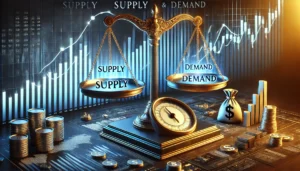

Introduction
The economics of supply and demand are the fundamental principles that drive economic systems worldwide. They determine everything from the price of everyday goods to large-scale market trends. Understanding how supply and demand work helps individuals, businesses, and policymakers make informed financial and economic decisions. In this article, we explore how these forces shape the economy, their determinants, and real-world applications.
1. What Is Supply and Demand?
A. Definition of Supply and Demand
- Supply: The quantity of a good or service that producers are willing to offer at various price levels.
- Demand: The quantity of a good or service that consumers are willing to purchase at different price levels.
- The law of supply and demand states that when demand increases and supply remains constant, prices rise; when supply increases and demand remains constant, prices drop.
B. The Equilibrium Price
- The point where supply meets demand is called market equilibrium.
- At this price, the quantity supplied matches the quantity demanded.
📌 Source: Investopedia – Understanding Supply and Demand
2. Factors Influencing Supply and Demand
A. Factors Affecting Demand
- Price of the product: Lower prices generally increase demand, while higher prices reduce it.
- Income levels: When consumer income rises, demand for normal goods increases.
- Consumer preferences: Trends, advertising, and cultural shifts influence demand.
- Substitutes and complements: Availability of alternative products impacts demand.
B. Factors Affecting Supply
- Production costs: Higher costs of raw materials reduce supply.
- Technological advancements: Improved technology can increase production efficiency.
- Government policies and taxes: Regulations and subsidies influence supply decisions.
- Market competition: The number of competitors affects supply levels.
📌 Source: Federal Reserve – Economic Supply and Demand Trends
3. The Relationship Between Supply and Demand
A. Price Elasticity of Demand and Supply
- Elastic goods: Products with high price sensitivity (e.g., luxury items).
- Inelastic goods: Necessities with less price sensitivity (e.g., gasoline, medicine).
B. Shortage vs. Surplus
- Shortage: Occurs when demand exceeds supply, leading to higher prices.
- Surplus: Happens when supply exceeds demand, causing prices to drop.
📌 Source: World Economic Forum – Market Forces of Supply and Demand
4. Real-World Applications of Supply and Demand
A. Housing Market Fluctuations
- High demand and limited supply lead to rising home prices.
- Economic downturns reduce demand, causing property values to decline.
B. The Impact on Oil Prices
- Global events like war or supply chain disruptions impact crude oil prices.
- Increased energy demand in developing nations drives higher oil prices.
C. Labor Market and Wages
- When labor supply is high, wages tend to decrease.
- A shortage of skilled workers increases wage levels.
📌 Source: International Monetary Fund (IMF) – Global Market Analysis
5. Government Intervention in Supply and Demand
A. Price Controls
- Price ceilings: Government-imposed maximum prices (e.g., rent control).
- Price floors: Minimum prices set by governments (e.g., minimum wage laws).
B. Subsidies and Tariffs
- Subsidies encourage production by lowering costs for producers.
- Tariffs protect domestic industries but may lead to higher consumer prices.
📌 Source: World Bank – Government Policies on Markets
Conclusion
Supply and demand are powerful forces shaping economies, influencing everything from consumer prices to job markets. By understanding these principles, individuals and businesses can make better financial decisions, and policymakers can develop strategies to stabilize economies.
Call to Action: How do you see supply and demand affecting your daily life? Let us know in the comments!
📌 Additional Resources:



